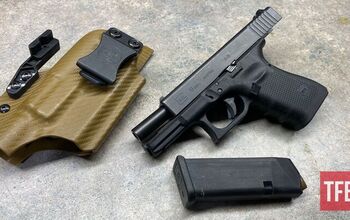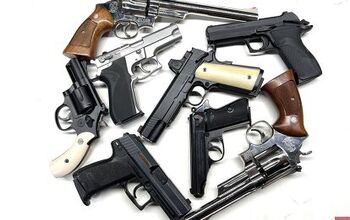QJZ-171 - The Lightest Weight 12.7x108 Machine Gun

The QJZ-171 large-caliber machine gun is a marvel of engineering, offering a 12.7x108 weapon that bridges the weight gap between medium and heavy machine guns. Surprisingly, it provides a larger caliber in a weapon that weighs as much as a typical general-purpose or medium-machine gun. The QJZ-171, also known as the mountain large-caliber heavy machine gun, is perhaps the lightest .50 caliber machine gun available, weighing only 26.4 lbs (11.9 kg). This weight is nearly the same as the M240 or MAG58, yet it provides a significantly increased range, surpassing the .338 Norma Magnum in range and kinetic energy.
Machine Guns @ TFB:
- Why the First Kalashnikov Machine Gun was a Complete Failure?
- REAPR – Ohio Ordnance Works' .338 Machine Gun
- FN Herstal – New FN MINIMI Mk3 Light Machine Gun
- Heckler & Koch Teases The HK 421 – A New Lightweight Machine Gun
The QJZ-171 is a modern adaptation of the time-tested Degtyaryov DShK heavy machine gun, though designed for military customers prioritizing mobility and overmatch capabilities. It is intended to replace the QJZ-89 heavy machine gun. It is produced by China North Industries Group Corporation Limited (Norinco), a well-known Chinese manufacturer of small arms and military hardware for domestic defense and export markets.
With a primary goal of weight reduction, the weapon utilizes a special lightweight alloy cartridge case while still allowing the use of standard-cased ammunition. This lightweight cartridge reduces the weight by 2.6 lbs (1.7 kg). For reference, a 60-round belt box of standard B-32 armor-piercing incendiary 12.7x108 ammunition weighs 17.85 lbs (8.09 kg).
According to available information, the outer receiver is made from carbon fiber plastic, while the latter is constructed from titanium alloy. It comes with a plastic 60-round ammunition box to minimize the weapon's weight. A special lightweight polymer link was also developed specifically for this weapon, further reducing weight compared to the standard steel DShK-38/46 ammunition links typically used.
For the 12.7x108 machine gun, the QJZ-171 demonstrates a light recoil, making it a more controllable weapon for its role and class. This recoil mitigation is accomplished by the receiver, which allows the barrel and bolt group to recoil inside the outer receiver housing. This system can be described as a "receiver within a receiver," where the inner receiver and barrel assembly recoil within the outer receiver. As a result, this significantly reduces recoil, leading to a hybrid short recoil system. A multi-chamber muzzle compensator is employed to further assist in reducing recoil. The videos of Chinese soldiers firing this weapon from a tripod with minimal recoil transmitted to the shooter and carrying it from the carry handle are pretty impressive.
The QJZ-171 machine gun is gas-operated and fires from the open bolt. It features a flapper-locking bolt mechanism inspired by the DShK. Currently, there is no specified rate of fire for the QJZ-171. The weapon uses either steel DShK-38/46 belts or lightweight polymer links to decrease weight further. Its controls include a pistol grip with a trigger and a shoulder stock equipped with a built-in spring recoil buffer assembly. The primary method for charging the weapon is using a lever from the right side. Above the charging handle is an emergency charging connection point, which can be used with a spent casing to charge the gun. The feed mechanism's lever on the right side indicates that the manual of arms for the 171 is similar, if not identical, to that of the DShK.
This may be an interim solution amid the proliferation of .338 Norma Magnum and the increased issuance of the QJZ-171. These lightweight machine guns can counter threats and provide the necessary overmatch, allowing them to outperform or overpower their adversaries, typically held by vehicle-mounted .50 caliber weapons.
According to Chinese sources, the stated effective range of this weapon is 1,500 meters. Still, it’s reasonable to assume that ranges of 2,000 meters or more wouldn’t be unrealistic, given the caliber, with a maximum range reported to be up to 7,000 meters.
The barrel is 31 inches (787mm) long, free-floating, and equipped with a multi-chamber muzzle compensator. One of the primary goals, alongside weight reduction, was to enhance the weapon's accuracy compared to the previous Type 89 heavy machine gun, and these objectives have been successfully met.
The QJZ-171 is operated by a two-person gun team consisting of a gunner and an ammo bearer. The weapon is notably lightweight for its caliber, allowing it to be carried with one hand to firing positions, as seen in released Chinese military videos. A short M1913 rail section has been added to the rear of the receiver to accommodate optical sights, further enhancing the weapon’s lethality. The QMK-171 5x magnified optic was designed to accompany the gun.
The development of the QJZ-171 is tailored for China’s mountainous terrain and high-altitude operations. The weight reduction facilitates movement, allowing soldiers to transport weapons more easily to firing positions. This weight reduction enables troops to go farther or carry more ammunition. In contrast, China may deploy its soldiers at higher altitudes in mountainous regions. This is reminiscent of the US requirements during operations in Afghanistan when transitioning from the M-240B to the MK-48 as a theater-issued weapon.
Reducing the weight of small arms is gaining traction in several countries, and China may be at the forefront of utilizing lightweight materials. This weight reduction applies to weapons, links, ammunition boxes, and lightweight alloy-cased ammunition. Combining these innovations increases lethality on the battlefield by enhancing mobility and improving overall logistics.
The lightweight tripod shown in the released photos and videos does a disservice to the mountain operations for which the weapon was developed. Weighing 13.2 lbs. (5.9 kg), it is made from an unspecified special alloy to reduce weight. However, most nations use such tripods merely as weapon holders rather than tools to improve the system's effectiveness. In mountainous environments, a better solution would involve engaging from a defilade position using a soft mount and an appropriate traverse and elevation mechanism. This approach would help maintain a consistent beaten zone pattern.
The QJZ-171 has already been issued to multiple branches of the Chinese military, indicating its potential for broader adoption or even export success. While it may be too early to make definitive predictions, the system certainly has considerable merit. However, the weight of the ammunition could limit its load capacity and reduce the weapon’s maneuverability. If tensions in the Indo-Pacific escalate, we may see a closer examination of the QJZ-171 or even find examples of its use in Africa.

Lynndon Schooler is an open-source weapons intelligence professional with a background as an infantryman in the US Army. His experience includes working as a gunsmith and production manager in firearm manufacturing, as well as serving as an armorer, consultant, and instructor in nonstandard weapons. His articles have been published in Small Arms Review and the Small Arms Defence Journal. https://www.instagram.com/lynndons
More by Lynndon Schooler














![[SHOT 2025] Dead Air Unveils Sandman X Suppressor](https://cdn-fastly.thefirearmblog.com/media/2025/01/24/18181/shot-2025-dead-air-unveils-sandman-x-suppressor.jpg?size=350x220)

![[SHOT 2025] Show Low Updates Their PCC Design, Working On 10mm Option](https://cdn-fastly.thefirearmblog.com/media/2025/01/24/02121/shot-2025-show-low-updates-their-pcc-design-working-on-10mm-option.jpg?size=350x220)





![[SHOT 2025] AAC's New Ranger 5 Reduced Back Pressure Silencer](https://cdn-fastly.thefirearmblog.com/media/2025/01/28/23344/shot-2025-aac-s-new-ranger-5-reduced-back-pressure-silencer.jpg?size=350x220)



Comments
Join the conversation
Everybody complains that China steals all the good ideas from everyone else, we need to steal a few of these and reverse engineer them. Given the smaller size of the 12.7x99 , the weight savings would be similar.
Well I for one hope every firearm the PRC fields has a muzzle blast a furlong wide and brighter than a nuclear thermal flash.